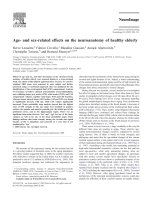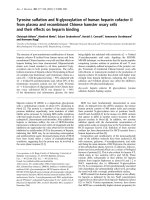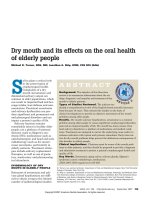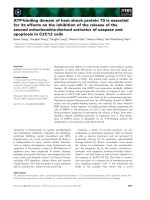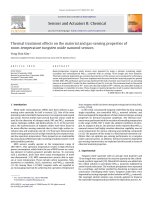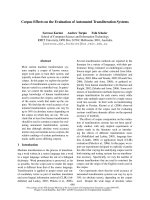Mechanisms of polymer ca2+ interaction and their effects on the characteristics of alginate microspheres and films 3
Bạn đang xem bản rút gọn của tài liệu. Xem và tải ngay bản đầy đủ của tài liệu tại đây (3.34 MB, 37 trang )
130
Part III. Influence of incorporating other polymers on the properties of the
alginate matrix
A. Light transmittance, thickness and percent weight loss of films and FTIR
spectroscopy
The copolymers chosen in this study are natural gums that have a long history
of applications in the food industry. These gums are safe, biocompatible and
biodegradable. Their influence on the properties of the alginate matrix was
investigated.
Light transmittance measurements are often used as an empirical method for
the determination of phase mixing in polymer composite materials (Krause, 1972).
Composite materials which are not homogeneous i.e. the individual polymers are not
completely miscible, will reduce light transmittance because of the quality of
scattered and reflected light. This will result in lower transmittance values of the
composite materials than those obtained from individual polymers (Zhou and Zhang,
2001).
Light transmittance through a film may also be affected by its thickness.
Preliminary studies using SA films showed insignificant difference in the percent
transmittance values obtained if the film thickness varied within 0.0389 to 0.0578 mm
(Table 18). Hence, this film thickness range was used for all test films in the
subsequent measurement of light transmittance in all studies.
Pectin and ι-carrageenan showed good miscibility with sodium alginate as
shown by the high light transmittance values of uncross-linked AP and AI films
(Table 19). Yoshida et al. (2001) found that the miscibility of polymers depended
strongly on polymer-polymer interactions, such that a slight difference in the
conformation of the polymer chain might affect the miscibility of the polymers with
131
Table 18. The influence of thickness of SA films on light transmittance.
Film thickness (mm)
Transmittance (%)*
0.0380 87.0
0.0396 86.7
0.0488 85.5
0.0526 84.8
0.0578 84.0
SA films were composed of sodium alginate (Manucol
®
DH, uncross-linked).
*Only 1 determination of light transmittance was carried out for the films of different thickness.
132
one another. This was especially evident with the addition of κ-carrageenan to
alginate. κ-carrageenan is structurally similar to ι-carrageenan with the exception of
having only 1 sulphate group (Figure 3) but the transmittance of uncross-linked AK
was significantly lower than that of uncross-linked AI. The addition of κ-carrageenan
and gellan gum to sodium alginate gave rise to lower light transmittance values
indicating that the polymers were not completely miscible (Table 19).
Thickness is an important film property as it affects the tensile strength and
permeability of films. The degree of cross-linking might also be reflected to a certain
extent by the percent change in film thickness after cross-linking. The changes in film
thickness after cross-linking are shown in Figure 22a. Although the amount of film
former (sodium alginate with or without copolymer) used was constant, significant
differences in film thickness were observed (p<0.05). This could be due to the
different extent of interaction between the polymer chains (Table 20).
The thickness of SA film was greatly reduced after cross-linking with Ca
2+
but less
change in film weight was observed (Figure 22). Stochiometrically, one mole of
calcium ion (atomic weight ≈ 40 g) displaces two moles of sodium ions (total atomic
weight ≈ 46 g). As there is little difference between the corresponding weights of the
cations exchanged, the weights of the film before and after cross-linking were
expected to be comparable. Any significant change in weight would imply a loss in
polymer content through dissolution during the cross-linking process. Hence, the
minimal change in weight of SA film after cross-linking showed insignificant
polymer loss during the cross-linking of sodium alginate. Decrease in the film
thickness could be due to the divalent calcium ions interacting with two binding sites
on different polymer chains, bringing the polymer chains closer together.
133
Table 19. Light transmittance of films.
Transmittance (%)
Film code
Uncross-linked films Cross-linked films
SA
87.00 ± 1.31 77.53 ± 0.60
PT 87.03 ± 0.59
71.70 ± 0.91
KC 70.65 ± 0.21
72.04 ± 1.62
IC 73.93 ± 1.73
76.40 ± 2.26
GG 87.25 ± 0.31
86.88 ± 0.20
AP90/10 85.93 ± 0.43 82.57 ± 0.56
AP70/30
85.37 ± 0.18 85.00 ± 0.72
AP50/50
84.07 ± 0.43 85.37 ± 0.03
AK90/10
80.10 ± 0.06 54.50 ± 2.18
AK70/30
49.00 ± 1.18 46.93 ± 1.59
AK50/50
46.67 ± 1.21 41.43 ± 1.00
AI90/10
85.97 ± 0.28 76.70 ± 0.79
AI70/30
78.77 ± 0.23 75.97 ± 1.47
AI50/50
77.17 ± 1.84 76.67 ± 0.41
AG90/10
44.40 ± 0.84 82.77 ± 0.66
AG70/30
35.60 ± 0.38 83.33 ± 0.07
AG50/50
56.90 ± 1.44 66.10 ± 1.64
134
Figure 22. Percent change in (a) film thickness and (b) film weight after the cross-
linking.
-35
-30
-25
-20
-15
-10
-5
0
5
10
0 10 30 50 100
% copolymer
% change in film thickness after cross-linking
Pectin
Kappa carrageenan
Iota carrageenan
Gellan gum
-30
-25
-20
-15
-10
-5
0
5
10
0 103050100
% copolymer
% change in film weight after cross-linking
Pectin
Kappa carrageenan
Iota carrageenan
Gellan gum
(a)
(b)
Copolymer
Copolymer
135
Table 20. Thickness of films before and after cross-linking.
Film thickness (mm)
Film code
Before cross-linking After cross-linking
SA
0.0577 ± 0.001 0.0483 ± 0.0014
PT 0.0627 ± 0.001 0.0436 ± 0.0011
KC 0.0550 ± 0.0005 0.0496 ± 0.0002
IC 0.0511 ± 0.0002 0.0444 ± 0.0002
GG 0.0593 ± 0.0006 0.0571 ± 0.0005
AP90/10 0.0549 ± 0.0016 0.0550 ± 0.0021
AP70/30 0.0591 ± 0.0024 0.0503 ± 0.0016
AP50/50
0.0624 ± 0.0026 0.0512 ± 0.0010
AK90/10 0.0499 ± 0.0012 0.0497 ± 0.0012
AK70/30 0.0527 ± 0.0011 0.0469 ± 0.0013
AK50/50
0.0550 ± 0.0019 0.0479 ± 0.0017
AI90/10 0.0493 ± 0.0009 0.0498 ± 0.0018
AI70/30 0.0488 ± 0.0005 0.0399 ± 0.0014
AI50/50 0.0489 ± 0.0008 0.0411 ± 0.0011
AG90/10 0.0544 ± 0.0007 0.0545 ± 0.0019
AG70/30 0.0553 ± 0.0011 0.0559 ± 0.0013
AG50/50
0.0574 ± 0.0012 0.0531 ± 0.0018
136
FTIR spectroscopy revealed interactions between Ca
2+
and the free carboxyl
groups in alginate. The strong band due to a C=O stretch of the carboxylic acid group
at 1737cm
-1
in alginic acid disappeared after cross-linking (Figure 23). This band was
also absent in both uncross-linked and cross-linked SA films. Furthermore, bands
between 1600-1615 cm
-1
and 1429-1417 cm
-1
became more prominent. These bands
were attributed to the COO
-
asymmetric and symmetric stretches in the cross-linked
alginates. A slight shift to lower wavenumber for asymmetric COO
-
stretch and to
higher wavenumber for symmetric COO
-
stretch after cross-linking indicated an
exchange of Na
+
for Ca
2+
.
With the exception of AG 70/30 films, significant decrease in thickness of
composite films containing at least 30 % of copolymer was observed after cross-
linking with Ca
2+
(p<0.05). Significant decrease in weight of composite films was
also observed. It has been shown that sodium alginate did not undergo polymer
dissolution during cross-linking. Hence, the decrease in the film weight was most
likely due to the dissolution of the copolymer. Greater % decrease in thickness of
composite films and film weight were generally observed with increased proportion
of copolymer incorporated (Figure 22). The percent weight loss after cross-linking
generally increased in the order of GG < KC < IC< PT. A linear relationship (r
2
=
0.984) between % decrease in thickness and % change in film weight was observed
for KC, IC and PT and GG films. This implied that the loss of copolymer during the
cross-linking process had a considerable effect on film thickness. Pectin dissolved
readily in water at room temperature while carrageenans and gellan gum were less
soluble. This might contribute to the apparent greater % weight loss observed in PT
and AP films after cross-linking as opposed to the other films. The presence of an
additional sulphate group in ι-carrageenan (Figure 3) makes it more hydrophilic and
137
Figure 23. FTIR spectra of alginic acid, uncross-linked and cross-linked SA films.
4000 3800 3600 3400 3200 3000 2800 2600 2400 2200 2000 1800 1600 1400 1200 1000 800 600 400
Wavenumber (cm
-1
)
1737 c
m
-1
Absorbance
Alginic
acid
Uncross-
linked SA
Cross-linked
SA
138
soluble in water than κ-carrageenan (Imeson, 2000). This contributed to the greater
loss of ι-carrageenan in the cross-linking process, compared to κ-carrageenan.
Interestingly, the SA film did not exhibit significant weight change after cross-
linking (p>0.05) even though sodium alginate dissolved easily in water. It could be
inferred that the rate of interaction between sodium alginate and the Ca
2+
was very
rapid and the affinity of alginate for Ca
2+
was much greater than the other copolymers,
thus forming insoluble calcium alginate immediately upon contact with Ca
2+
. This
was supported by a higher Ca
2+
content obtained in cross-linked alginate films as
compared to the other cross-linked films (Figure 24).
The percent reduction in thickness of the composite films after cross-linking
was generally markedly higher than the percent reduction in weight (Figure 22).
Therefore, the loss in polymer contents could not account for the reduction in film
thickness totally. Interaction between Ca
2+
and the remaining polymer also
contributed to the reduction in film thickness. The different Ca
2+
contents of the films
composed of a single polymer revealed that there might be varying affinity of the
polymers for Ca
2+
thus introducing the potential for varying degrees of cross-linking
in the film matrix.
The interaction between pectin and Ca
2+
occurs mainly through the carboxyl
groups in pectin. The strong band at 1743.3 cm
-1
in pectinic acid is due to the C=O
vibration of the methyl ester and free carboxyl groups (Figure 25). The decreased
intensity of this strong band with increased prominence of bands between 1680-1670
cm
-1
and 1417-1426 cm
-1
were associated with asymmetric and symmetric COO
-
stretching vibrations of the carboxyl groups and they provided strong evidence of
cation-carboxyl interaction. Cross-linking of sodium pectinate with Ca
2+
resulted in a
slight decrease in wavenumber of the asymmetric COO
-
stretching band and an
139
Figure 24. Calcium content of polymeric films after cross-linking.
0
10
20
30
40
50
60
70
80
90
100
SA PT KC IC GG
Type of film
Ca
2+
content (mg/g of film)
140
Figure 25. FTIR spectra of pectinic acid, uncross-linked and cross-linked SA, PT and
AP films.
2000 1800 1600 1400 1200 1000 800
Wavenumber (cm
-1
)
Absorbance
1743.3 cm
-1
1126.2 cm
-1
1097.3 cm
-1
1147.4 cm
-1
1102.2 cm
-1
1126.2 cm
-1
Uncross-linked
SA
Cross-linked
SA
Pectinic acid
Uncross-linked
PT
Cross-linked
PT
Uncross-linked
AP
Cross-linked
AP
141
increase in wavenumber of the symmetric COO
-
stretching band (Figure 25). Pectin
creates junction zones by ordered side-by-side associations of the galacturonans,
whereby specific sequences of galacturonic acid monomers in parallel or adjacent
chains are linked intermolecularly through electrostatic and ionic bonding of carboxyl
groups forming an ‘egg box’ structure similar to that proposed for the alginates (Grant
et al.,1973).
The formation of the ‘egg box’ structure between polymer chains of the same
type enables close packing of the dimers formed. A film with closely packed polymer
chains would be expected to exhibit a lower light transmittance because of its greater
ability to block light. This was reflected by decreased film thickness and lower light
transmittance of SA and PT films after cross-linking (Table 19 and Figure 22).
The % decrease in SA film thickness after cross-linking was >16 % and that of
PT films is >30 %. However, the decrease in film thickness of AP 90/10 and AP
70/30 after cross-linking was less than 15 % despite having a high proportion of
alginate. It was also observed that for AP 50/50, the decrease in film thickness after
cross-linking is only 18 % although PT films showed significant film thickness
change (Figure 22a). The methoxy and amide groups scattered along the pectin chains
do not interact with Ca
2+
. Their presence could hinder the formation of the ‘egg box’
structure with alginate. Therefore interactions between alginate and pectin are likely
to occur along some segments of the polymer chains, resulting in the composite film
having a more loosely packed structure than the SA and PT films (Figure 26). The
interaction between the polymers and Ca
2+
were evident from FTIR studies (Figure
25). In uncross-linked AP films, bands at 1147.4 cm
-1
and 1101.2 cm
-1
, which were
due to C-O-C vibration of the gylcosidic linkage/ring and ring associated vibrations
142
Figure 26. Schematic representation of possible interactions between pectin and
alginate with calcium ions ({).
Pectin
Sodium
alginate
Region with methoxy groups
143
CO, CC, CCH, OCH) (Wellner et al., 1998) of pectin, were clearly observed (Figure
25).
However, these bands were either absent (band 1147.4 cm
-1
) or shifted to a
lower wavenumber (band 1102.2 cm
-1
) in the cross-linked AP films. In addition, 2
bands at 1126.2 cm
-1
(C-C stretch and C-O stretch) and 1097.3 cm
-1
(C-O stretch and
C-O-C stretch) in uncross-linked SA films were not present in uncross-linked AP
films but became prominent in cross-linked AP films. These 2 bands were associated
with G blocks of the alginate (Sartori et al., 1997) which mainly involved interactions
with Ca
2+
. Thus, the above observations from the FTIR spectra indicated a change in
polymer ring and linkage conformation before and after cross-linking in both
polymers, suggesting interactions between the two types of polymer chains in the
cross-linking process. The higher light transmittance of cross-linked AP films as
compared to cross-linked SA and PT films further supported the presence of
interactions between the polymers, mediated by Ca
2+
, with greater miscibility between
the polymers.
In composite films containing carrageenan, the reduction in film thickness was
considerably greater than the change in film weight after cross-linking indicating that
interaction between Ca
2+
and polymer chains greatly influenced the film thickness
(Figure 22a).The Ca
2+
enhanced gelation of κ-carrageenan by stabilization of the
helical conformation of the polymer, through shielding of the charge of sulphate
groups by Ca
2+
(Watase and Nishinari, 1986). This phenomenon enabled tight binding
and enhanced aggregation of the helices, which accounted for the reduction in
thickness of KC and AK films after cross-linking. The increased aggregation of the
helices was reflected by the lower transmittance of KC and AK films as compared to
SA films (Table 19). The gels formed by interaction of κ-carrageenan with Ca
2+
had
144
been described as ‘turbid’ by Michel et al. (1997). FTIR studies revealed possible
interactions of sodium alginate and κ-carrageenan with Ca
2+
and with each other. A
series of bands in the region 1150-1000cm
-1
of SA
had been reported to shift to lower
wavenumbers as the calcium content increases and the authors attributed the shift to
C-C and C-O bond-sharing with calcium ion (Sartoris et al., 1997). The shift to lower
wavenumber for these bands in SA indicated binding with Ca
2+
(Figure 27). Bands
around 1260 cm
-1
and 1230 cm
-1
for carrageenans were due to O=S=O antisymmetric
stretching vibration. The shoulder around 1230 cm
-1
in KC became visible only after
cross-linking with Ca
2+
(Figure 27). The possible interaction between anionic sulphate
groups and Ca
2+
was further supported by the presence of the band at 1236.2 cm
-1
in
cross-linked AK, as this was not observed in uncross-linked AK.
The band at 1616.1 cm
-1
in uncross-linked AK films shifted to a higher
wavenumber after cross-linking. This band is attributed to the asymmetric COO
-
stretch in SA. However, in uncross-linked SA, this band was shifted to a lower
wavenumber after cross-linking. Thus, the band shift observed in AK films after
cross-linking could not be attributed only to bonds between Ca
2+
and alginate but also
to the possible interaction between the carboxyl groups of SA and other hydrophilic
groups on KC. This band in the range of 1640-1645 cm
-1
in KC was due to polymer
bound water (Abad et al., 2003). Thus, the hydrophilic groups in KC could be
involved in interaction with SA in the composite films. The band at 1419.4 cm
-1
in
uncross-linked AK shifted to 1429.0 cm
-1
after cross-linking. In uncross-linked SA,
the band around 1419 cm
-1
was due to the symmetric COO
-
stretch and this band
shifted to a higher wavenumber in cross-linked SA. Bands between 1500-1270 cm
-1
in
carrageenans were a result of coupling of CCH bending motions in the molecule
(Sekkal and Legrand, 1993). Thus, it is highly likely that the significant band shift
145
Figure 27: FTIR spectra of uncross-linked and cross-linked SA, KC and AK films.
2000 1800 1600 1400 1200 1000 800
Wavenumber (cm
-1
)
1417.4 cm
-1
1421.3 cm
-1
1430.9 cm
-1
1234.2 cm
-1
1616.1 cm
-1
1419.4 cm
-1
1261.2 cm
-1
1623.7 cm
-1
1429.0 cm
-1
1236.2 cm
-1
Uncross-linked
SA
Cross-linked SA
Uncross-linked
KC
Cross-linked KC
Uncross-linked
AK
Cross-linked AK
Absorbance
146
from 1419.4 cm
-
1 to 1429.0 cm
-1
observed in AK films after cross-linking was due to
the band shift in cross-linking. The shoulder at 1430.9 cm
-1
in uncross-linked KC was
no longer observed in the FTIR spectrum of cross-linked KC. The observations
further supported alginate-KC interaction. Hence, interactions between alginate and
carrageenan in the presence of Ca
2+
were responsible for the increased % reduction in
film thickness in AK composite films with increasing proportion of KC (Figure 22a).
For ι-carrageenan, each cross-linking cation is coordinated to two sulphate
groups, each from a different double helix, in such a way as to produce a Ca
2+
-
sulphate-Ca
2+
-sulphate… chain running through the lattice parallel to the fibre axis.
Thus, each double helix is linked to its neighbours by cations forming a complete
three dimensional system (Arnott and Scott, 1974). Therefore, Ca
2+
not only connects
and balances the charge on two sulphate groups from the different helices but it also
brings the helices closer (Janaswamy and Chandrasekaran, 2002), producing thinner
IC and AI cross-linked films (Figure 22a). The prominent band around 1260 cm
-1
in
the FTIR spectra, attributed to antisymmetric stretch of O=S=O in IC, became less
prominent and shifted to a higher wavenumber after cross-linking in cross-linked IC
films (Figure 28). The observation suggests that there is interaction of Ca
2+
with IC.
FTIR evidence also highlighted probable interactions between the sulphate groups in
IC and alginate. Bands in uncross-linked AI at 848.5 cm
-1
and 806.1 cm
-1
, associated
with galactose-4-sulphate and 3, 6-anhydrogalactose-2-sulphate of iota carrageenan,
were shifted to 894.8 cm
-1
and 819.6 cm
-1
respectively after cross-linking with Ca
2+
.
These bands in IC were also shifted to a higher wavenumber after cross-linking,
indicating interactions between Ca
2+
and the macromolecules of AI. However, the
extent of the band shift was considerably larger with cross-linked AI than IC. In
147
Figure 28. FTIR spectra of uncross-linked and cross-linked SA, IC and AI films.
1500 1400 1200 1000 800 700
Wavenumber (cm
-1
)
1263.2 cm
-1
931.5 cm
-1
931.5 cm
-1
848.5 cm
-1
806.1 cm
-1
948.8 cm
-1
894.8 cm
-1
819.6 cm
-1
Uncross-linked
SA
Cross-linked
SA
Uncross-linked
IC
Cross-linked
IC
Uncross-linked
AI
Cross-linked
AI
Absorbance
148
addition, the band observed at 931.5 cm
-1
in uncross-linked AI due to C-O stretching
vibration of the 3, 6 anhydro bridge became less prominent and shifted to 948.8 cm
-1
with addition of Ca
2+
suggesting possible changes in chain conformation in IC as a
result of interactions with alginate.
However, this band shift was less significant in IC after cross-linking (Figure
28). The polymer chain interactions of alginate and iota-carrageenan after cross-
linking resulted in pronounced change in film thickness (Figure 22a). The greater
decrease in film thickness of AI and AK films with insignificant change in weight
after cross-linking further emphasized the polymer-polymer interaction between the
alginate and carrageenans. High light transmittance levels in cross-linked ι-
carrageenan films were also observed (Table 19). ι-carrageenan produced gels with
greater clarity than κ-carrageenan when Ca
2+
was used as the cross-linking agent
(Michel et al., 1997). This was also observed in the present study where the cross-
linked AI films showed higher % of light transmittance than cross-linked AK films
(Table 19).
For GG and AG films, no significant change in film thickness and film weight
were observed after cross-linking (p>0.05) (Figure 22). This could be due to the
following possible reasons. Gellan gum has a very high molecular weight and heat is
required to dissolve the gum in water. The cross-linking of polymer films was carried
out at room temperature of 24 ± 1 °C. At this temperature, there would be negligible
dissolution of gellan gum during cross-linking.
Gellan gum forms Ca
2+
mediated junction zones by a combination of charge
screening by the cations between negatively charged polymer chains and cross-linking
between double helices through interaction of Ca
2+
with the carboxyl groups of
adjacent polymer chains (Chandrasekaran and Radha, 1995). Alginate also cross-
149
linked with Ca
2+
through interactions with carboxyl groups on adjacent polymer
chains forming the ‘egg box’ structure with subsequent formation and aggregation of
the dimers. The cross-linked chains might be more densely packed for calcium
alginate as compared to cross-linked gellan gum. This could be explained by
differences in the number of carboxyl groups present in the polymers. Sodium
alginate has 2 carboxyl groups in each repeating unit whereas gellan gum has only
one carboxyl group (Figures 1 and 3). Therefore, some of the carboxyl groups in SA
might not be involved in interactions with the gellan gum molecules although
hydrogen bonds between –OH and –COO
-
of the polymers are possible. Hence, the
chains in the cross-linked AG films were not in as close proximity as those in cross-
linked SA films, giving rise to a smaller change in thickness of AG films than SA
films after cross-linking. Moreover, there was also lower light transmittance through
cross-linked SA films than cross-linked AG and GG films due to more dense packing
of polymer chains in cross-linked SA (Table 19).
Evidence of an interactions between alginate and gellan gum could be
observed using FTIR studies. The band at 1157.1 cm
-1
due to ethereal stretching in
gellan gum was seen in uncross-linked GG films. This band was unaffected after
cross-linking (Figure 29). However, a similar band present at 1155.2 cm
-1
in the FTIR
spectrum of uncross-linked AG films shifted to 1145.5 cm
-1
after cross-linking, thus
supporting the postulation that an interaction existed between the two polymers. The
band shift suggested a change in the chain conformation of gellan gum involving
shifts at the ether linkage.
In summary, film thickness was governed by the ease of the constituent
polymer to dissolve in the cross-linking medium and the extent of interaction between
the cross-linker and polymer chains, bringing the chains closer together. The findings
150
Figure 29. FTIR spectra of uncross-linked and cross-linked SA, GG and AG films.
1500 1400 1200 1000 800 700
Wavenumber (cm
-1
)
Uncross-
linked SA
Cross-
linked SA
Uncross-
linked GG
Cross-
linked GG
Uncross-
linked AG
Cross-
linked AG
Absorbance
1157.1 cm
-1
1155.2 cm
-1
1145.5 cm
-1
151
indicated that the latter played a more significant role in determining film thickness.
In addition, the thickness of composite alginate films was affected by the proportion
and type of copolymer used, to different degrees.
B. Tensile properties of films
Tensile strength indicates film toughness whereas the elastic modulus is
indicative of the rigidity of a film. A matrix with high tensile strength is associated
with product integrity and ease for product to be handled. In addition, high tensile
strength and low elastic modulus are desirable properties especially for films used as a
dosage form, in order to withstand stress and handling. Miscibility between the
polymers is essential to achieve the desirable mechanical properties of a resultant
film. The tensile strength and elastic modulus of the films studied are shown in
Figures 30 and 31.
Except for AK90/10 and AI90/10 films, all the uncross-linked composite films
had significantly lower elastic modulus than uncross-linked SA films (p<0.05).
Except for AK 90/10, they also had significantly lower tensile strength. Addition of
gums, particularly at concentrations exceeding 10 %, produced a negative impact on
the strength of the resultant film matrix. With the exception of AG films, other
uncross-linked composite films generally absorbed more moisture than uncross-linked
SA films, as illustrated by the greater extent of moisture sorption in the humidity
chamber (Figure 32). This could account for the lower elastic moduli of these films as
water can act as a plasticizer to reduce the films’ rigidity (Figure 32) (Keely et al.,
1995).
Polymer blending involves a balance between self-association (alginate-
alginate, copolymer-copolymer) and hetero-association (alginate-copolymer) of
152
Figure 30. Tensile strength of uncross-linked ( ) and cross-linked ( ) films and the
% difference ( ) in tensile strength of the film after cross-linking.
0
10
20
30
40
50
60
70
80
90
0 10 30 50 100
% pectin added to the films
Tensile strength (N/mm
2
)
0
5
10
15
20
25
30
35
% difference in tensil
e
strength
0
10
20
30
40
50
60
70
80
90
100
0 103050100
% kappa carrageenan added to the films
Tensile strength (N/mm
2
)
-25
-20
-15
-10
-5
0
5
10
15
20
25
30
% difference in tensil
e
strength
0
10
20
30
40
50
60
70
80
90
0 103050100
% iota carrageenan added to the films
Tensile strength (N/mm
2
)
0
5
10
15
20
25
% difference in tensil
e
strength
0
10
20
30
40
50
60
70
80
90
0 10 30 50 100
% gellan gum added to the films
Tensile strength (N/mm
2
)
0
10
20
30
40
50
60
70
% difference in tensil
e
strength
153
Figure 31. Elastic moduli of uncross-linked ( ) and cross-linked ( ) films and the %
difference ( ) in elastic moduli of the film after cross-linking.
0
500
1000
1500
2000
2500
3000
3500
0103050100
% kappa carrageenan added to the films
Elastic modulus (N/mm
2
)
-15
-10
-5
0
5
10
15
20
25
30
35
% difference in
elastic modulus
0
500
1000
1500
2000
2500
3000
0 103050100
% iota carrgeenan added to the films
Elastic modulus (N/mm
2
)
0
20
40
60
80
100
120
140
160
% difference in
elastic modulus
0
500
1000
1500
2000
2500
0 10 30 50 100
% gellan gum added to the films
Elastic modulus (N/mm
2
)
0
5
10
15
20
25
30
35
40
45
50
% difference in
elastic modulus
0
500
1000
1500
2000
2500
3000
0103050100
% pectin added to the films
Elastic modulus (N/mm
2
)
0
20
40
60
80
100
120
140
% difference in
elastic modulus
154
Figure 32. Extent of moisture sorption of uncross-linked ( ) and cross-linked ( )
film placed in climatic chamber.
0
10
20
30
40
50
60
70
0 10 30 50 100
% of pectin added to the films
Extent of moistur
e
sorption (%)
0
10
20
30
40
50
60
70
80
0103050100
% of kappa carrageenan added to the films
Extent of moistur
e
sorption (%)
0
10
20
30
40
50
60
70
80
0 103050100
% of iota carrageenan added to the films
Extent of moistur
e
sorption (%)
0
10
20
30
40
50
60
70
0 10 30 50 100
% of gellan gum added to the films
Extent of moistur
e
sorption (%)


